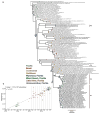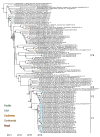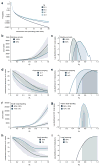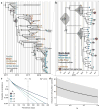Genomic epidemiology reveals multiple introductions of Zika virus into the United States
- PMID: 28538723
- PMCID: PMC5536180
- DOI: 10.1038/nature22400
Genomic epidemiology reveals multiple introductions of Zika virus into the United States
Abstract
Zika virus (ZIKV) is causing an unprecedented epidemic linked to severe congenital abnormalities. In July 2016, mosquito-borne ZIKV transmission was reported in the continental United States; since then, hundreds of locally acquired infections have been reported in Florida. To gain insights into the timing, source, and likely route(s) of ZIKV introduction, we tracked the virus from its first detection in Florida by sequencing ZIKV genomes from infected patients and Aedes aegypti mosquitoes. We show that at least 4 introductions, but potentially as many as 40, contributed to the outbreak in Florida and that local transmission is likely to have started in the spring of 2016-several months before its initial detection. By analysing surveillance and genetic data, we show that ZIKV moved among transmission zones in Miami. Our analyses show that most introductions were linked to the Caribbean, a finding corroborated by the high incidence rates and traffic volumes from the region into the Miami area. Our study provides an understanding of how ZIKV initiates transmission in new regions.
Conflict of interest statement
The authors declare no competing financial interests.
Figures












Comment in
-
Epidemiology: Molecular mapping of Zika spread.Nature. 2017 Jun 15;546(7658):355-357. doi: 10.1038/nature22495. Epub 2017 May 24. Nature. 2017. PMID: 28538722 No abstract available.
Similar articles
-
Zika virus evolution and spread in the Americas.Nature. 2017 Jun 15;546(7658):411-415. doi: 10.1038/nature22402. Epub 2017 May 24. Nature. 2017. PMID: 28538734 Free PMC article.
-
Genomic epidemiology supports multiple introductions and cryptic transmission of Zika virus in Colombia.BMC Infect Dis. 2019 Nov 12;19(1):963. doi: 10.1186/s12879-019-4566-2. BMC Infect Dis. 2019. PMID: 31718580 Free PMC article.
-
Surveillance of Zika virus in field-caught Aedes aegypti and Aedes albopictus suggests important role of male mosquitoes in viral populations maintenance in Medellín, Colombia.Infect Genet Evol. 2020 Nov;85:104434. doi: 10.1016/j.meegid.2020.104434. Epub 2020 Jun 21. Infect Genet Evol. 2020. PMID: 32580028
-
Modes of Transmission of Zika Virus.J Infect Dis. 2017 Dec 16;216(suppl_10):S875-S883. doi: 10.1093/infdis/jix396. J Infect Dis. 2017. PMID: 29267909 Free PMC article. Review.
-
Zika virus-spread, epidemiology, genome, transmission cycle, clinical manifestation, associated challenges, vaccine and antiviral drug development.Virology. 2020 Apr;543:34-42. doi: 10.1016/j.virol.2020.01.015. Epub 2020 Feb 2. Virology. 2020. PMID: 32056845 Review.
Cited by
-
Analysis of Zika Virus Sequence Data Associated with a School Cohort in Haiti.Am J Trop Med Hyg. 2022 Sep 12;107(4):873-880. doi: 10.4269/ajtmh.22-0204. Print 2022 Oct 12. Am J Trop Med Hyg. 2022. PMID: 36096408 Free PMC article.
-
Better surveillance to protect mothers and infants from Zika.Lancet Infect Dis. 2019 Oct;19(10):1047-1048. doi: 10.1016/S1473-3099(19)30473-6. Lancet Infect Dis. 2019. PMID: 31559951 Free PMC article. No abstract available.
-
A natural polymorphism in Zika virus NS2A protein responsible of virulence in mice.Sci Rep. 2019 Dec 27;9(1):19968. doi: 10.1038/s41598-019-56291-4. Sci Rep. 2019. PMID: 31882898 Free PMC article.
-
The Asian Lineage of Zika Virus: Transmission and Evolution in Asia and the Americas.Virol Sin. 2019 Feb;34(1):1-8. doi: 10.1007/s12250-018-0078-2. Epub 2019 Jan 25. Virol Sin. 2019. PMID: 30684211 Free PMC article. Review.
-
Urbanization favors the proliferation of Aedes aegypti and Culex quinquefasciatus in urban areas of Miami-Dade County, Florida.Sci Rep. 2021 Nov 26;11(1):22989. doi: 10.1038/s41598-021-02061-0. Sci Rep. 2021. PMID: 34836970 Free PMC article.
References
-
- Zika virus and complications. World Health Organization; [Accessed: 1st November 2016]. Available at: http://www.who.int/features/qa/zika/en/
-
- Likos A, et al. Local Mosquito-Borne Transmission of Zika Virus - Miami-Dade and Broward Counties, Florida, June-August 2016. MMWR Morb Mortal Wkly Rep. 2016;65:1032–1038. - PubMed
-
- Mosquito-Borne Disease Surveillance. Florida Department of Health; [Accessed: 10th January 2017]. Available at: http://www.floridahealth.gov/diseases-and-conditions/mosquito-borne-dise....
-
- Hennessey M, Fischer M, Staples JE. Zika Virus Spreads to New Areas — Region of the Americas, May 2015–January 2016. MMWR Morb Mortal Wkly Rep. 2016;65:1–4. - PubMed
Publication types
MeSH terms
Grants and funding
- U19 AI115589/AI/NIAID NIH HHS/United States
- R01 AI099210/AI/NIAID NIH HHS/United States
- MC_PC_15100/MRC_/Medical Research Council/United Kingdom
- UL1 TR001114/TR/NCATS NIH HHS/United States
- MR/L015080/1/MRC_/Medical Research Council/United Kingdom
- R35 GM119774/GM/NIGMS NIH HHS/United States
- U01CK000510/ACL/ACL HHS/United States
- T32 AI007244/AI/NIAID NIH HHS/United States
- UL1 TR000460/TR/NCATS NIH HHS/United States
- U01 CK000510/CK/NCEZID CDC HHS/United States
- 260864/ERC_/European Research Council/International
- HHSN272201400048C/AI/NIAID NIH HHS/United States
- S10 OD020069/OD/NIH HHS/United States
- WT_/Wellcome Trust/United Kingdom
- MR/M501621/1/MRC_/Medical Research Council/United Kingdom
- U54 GM088491/GM/NIGMS NIH HHS/United States
LinkOut - more resources
Full Text Sources
Other Literature Sources
Medical
Molecular Biology Databases

